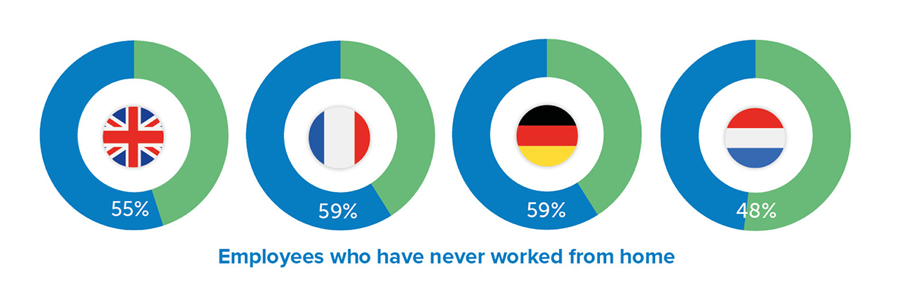Why the future of work in Europe is dynamic

Having lived in Denmark, Germany and the UK, I consider myself a “true European”. I’ve observed subtle differences in the working cultures of each country so was intrigued to see the results of our recent Okta YouGov research of 6,000 office workers across the UK, Germany, France and the Netherlands. Given the backdrop of COVID-19, there is undoubtedly a moment in time when we are all reflecting on how we would like to live and work going forwards, both personally and professionally.
Over the years I have worked for a number of more traditional organisations where I have observed that behaviour change is more often than not incremental. We simply don’t make large voluntary unprompted changes to our established routines and habits, whatever country we live in. I guess it’s not that we don’t want to, more that the inertia of the status quo is powerful.
To illustrate my point, the technology to enable a more dynamic culture of work has existed for a while, but it’s taken the ripple effect of COVID-19 to create a new cultural acceptance of what work for millions of us could look like and feel like. I have seen how this acceptance has created rapid demands and challenges for many CIOs and CISOs across Europe. On their shoulders falls the responsibility to quickly and securely scale this new workplace reality for the long-term.
Over the years we’ve all observed a major rise in adoption and use of applications that enable people to work from anywhere (like Zoom and Slack), proving that the technology we need is available and works. What COVID-19 has done is to put this technology to the test at an unprecedented scale and speed. I’ve witnessed first-hand how the pedestrian progress of digital transformation within many organisations has gone overnight from an amble to a scrambled sprint. That inevitably causes pain somewhere. From my experience, more often than not, the pain sits with the CIO and CISO, who are instructed to magically make this happen across complex and often inherited digital infrastructure.

Our research revealed that while many employees had previously been afforded the flexibility of working from home, on average around half the work-force surveyed had never worked from home. Working in the technology sector, it’s easy to forget that not everyone has the luxury of a potentially fluid working routine. Manufacturing, construction and real estate are sectors it seems that rely heavily on a traditional working environment. I imagine adapting to a new working regime has been particularly painful for those organisations who have lagged behind in implementing wide-scale digital transformation.
The failure to implement processes to enable employees to access their tools remotely has been thrown into the spotlight at a time when business survival depends on the speed of adaptability. Creating new ways to establish something that resembles a new secure business as usual, not built around the concept of a physical office, has fallen overnight on the shoulders of CIOs.
Interestingly, the public sector seems to have edged the private sector in terms of digital hardware readiness across the UK, Germany and France, although the reverse is true in the Netherlands.
The IT industry, perhaps unsurprisingly, were leaders in their preparation for remote work, with 81% of employees having the required equipment. At the other end of the spectrum, only 29% of retail employees found themselves with the equipment that they needed to deliver productively.
In all forms of nature, sudden and sizeable migrations attract the inevitable attention of predators looking to take advantage. COVID-19 has proved no different. The sudden increase in the threat surface, with entire workforces working remotely, has pushed IT security to the top of the agenda as employee endpoints look increasingly vulnerable when used outside the office.
Since the COVID-19 pandemic began, companies across the globe have reported a worrying surge in cyber security incidents. In March alone CTI League took down 2,833 indicators of compromise, 99.4% which were malicious domains attempting to exploit the pandemic.
In my experience security starts with trust, and less than a third of those surveyed expressed complete confidence in their employer’s online security to allow them to work from home. On the flipside though it appears that an organisation’s trust that their employees will be productive when working remotely has grown. At Okta we’ve always found that trust in employees is rewarded with performance. On average two thirds of those surveyed believed that company perceptions of their productivity when remote working had improved. Trust it seems is a two-way street, and one that both organisations and employees now seem more confident than ever to travel down.

It seems to me that the knock-on effect is that the traditional five-day-a-week office should quickly become a thing of the past. Progressive employers will have to choose between re-organising their workplaces or looking for new flexible office space rather than long-term leases, as staff resist the need to spend substantial time and expense commuting. The flexible working horse has bolted and won’t be shut behind the stable door again.
Not every employee though is yet it seems equally equipped in their domestic environments to benefit from the collision of work and home lives that COVID-19 has brought. Technology cannot alone create a productive remote workforce. Sharing your newfound workspace with flatmates, children and extended family creates a confusing emotional conflict of priorities, which we are all still learning to navigate effectively and successfully.
Although almost everyone surveyed had quickly become comfortable with video-calling, more of those surveyed missed the actual face-to-face interactions with work colleagues than the dedicated office workspace itself. We are, it seems, still social work creatures at heart, but tellingly no more than a third wanted to return to the office full-time. That’s food for thought for the leaders of organisations like myself; something which cannot be ignored.

At Okta our vision of the future of work has a name: Dynamic Work. It is a much bigger picture than simply equipping employees with laptops to work from anywhere. It’s about providing employees with comparable benefits, flexibility and experiential work environments in the location that best fits their needs; empowering employees to be their most productive and successful selves wherever they work.
I believe that for too long many organisations have been slow to acknowledge and accommodate each of our individual working preferences or needs. I know that the way I am most productive varies massively from some of my colleagues. Why can’t we all embrace and cater for these differences to improve our collective productivity? The technology exists to create a virtuous circle of Dynamic Work focusing on Agility, Productivity and Security. The time has come to implement it.
Facilitating flexibility and enabling employees to work and live where it makes most sense for each of them should be the new lens through which employers evaluate their business and people strategies. This will of course fit more swiftly and seamlessly with some industries than others.
I’ve observed throughout my career that being able to improve an employee’s work/life balance is often the single biggest key to them feeling happier, reducing stress and being more productive while at work. The companies that acknowledge this and act on it, benefit most.
By reducing the focus on the physical office, I can see how company overhead costs can also be lowered and the burden of exhausting commutes and expensive workplace attire reduced for our employees.
If there is to be a silver lining to the cloud of COVID-19, then I believe perhaps it will be the acceleration of the move towards a truly dynamic way of working and the demise of the more archaic workplace structures, which we have all accepted as the norm for too long. A healthier way to work for everyone across Europe and the world.
To help organisations move faster along this path, Okta have created a list of some of the most popular remote work tools within the categories of video conferencing, document collaboration, VPNs, and others. In addition to the list, we’ve included links to each tool’s respective free trials, as well as documentation to help with integrating them with Okta. If your organisation is looking to quickly roll out identity management for remote working, you can get started using Okta for Emergency Remote Work.

